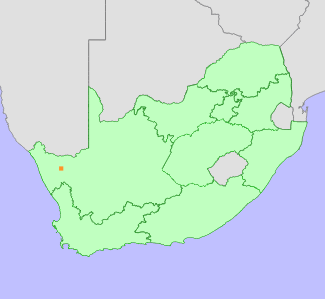|
Scientific Name | Conophytum vanheerdei Tischer |
Higher Classification | Dicotyledons |
Family | AIZOACEAE |
National Status |
Status and Criteria | Critically Endangered A4cd; B1ab(iii,v)+2ab(iii,v) |
Assessment Date | 2021/12/10 |
Assessor(s) | A.J. Young, P.G. Desmet, I. Ebrahim, D. Guo, A. Harrower, L. Jabar, L. Knoetze, C. Rodgerson, P.C.V. Van Wyk & N.N. Mhlongo |
Justification | A range-restricted species (EOO <5 km²) known from a single location where it is not threatened.This succulent is endemic to the Northern Cape province of South Africa with an extent of occurrence (EOO) and area of occupancy (AOO) of 4 km2. The population is in severe decline due to illegal collection for the international trade in ornamental succulents since 2019. Illegal collection is likely to increase as there has been a dramatic increase in the number of species and volume of plants targeted since 2019 including many from the immediate area. The continued threat of illegal collection is therefore regarded as extremely high for this particular species. The single location and very small population size of fewer than 700 mature individuals makes the species very susceptible to rapid declines. Loss of vegetation cover has been observed at this site via Landsat imagery between 1984 and 2018 and is used to infer that the habitat quality is already in decline. A complete decline of up to 100% of the population due to collection is very likely within the next ten years. While climate change is also likely to impact this taxon the rapid declines to the population as a result of illegal collection means it qualifies as Critically Endangered under criteria A4 and B1+2. |
Distribution |
Endemism | South African endemic |
Provincial distribution | Northern Cape |
Range | This species is endemic to the Northern Cape province of South Africa where it is only found in a single location with a severely restricted geographic range. |
Habitat and Ecology |
Major system | Terrestrial |
Major habitats | Bushmanland Inselberg Shrubland |
Description | This succulent is endemic to the Richtersveld bioregion of the Succulent Karoo biome. The plants inhabit quartzite formations usually in full sun. This species has a generation length of 30 years. It is expected to be sensitive to the impacts of climate change as it does not disperse and while adapted to arid conditions, is dependent on limited seasonal rainfall. Species in the genus are sensitive to long periods of drought. Drought related mortality has been observed for other closely related taxa within the genus. |
Threats |
| Plants have been subject to illegal collection of mature individuals for the international trade in ornamental succulents with several hundred plants, representing at least 50% of the population, being removed from habitat since 2019. This taxon has been highly sought after by collectors and is highly likely to remain so in future.
Loss of vegetation cover has been observed across the geographic range occupied by this species via Landsat imagery between 1984 and 2018 indicating a decline in habitat quality. Anthropogenic climate change is also a long-term threat to this species. Climate models for the likely emission scenarios where emissions stay at present day levels (RCP 2.6) (Hausfather and Peters 2020) and worst case scenarios where emissions continue to increase during the 21st century (RCP 8.5) indicate that there will be a loss of suitable bioclimatic envelope of between 56% and 98% by 2080 for this species. However, as this taxon possesses certain traits likely to afford resilience to xerophytic conditions it is expected to have a level of resilience to climate change and the expected population loss is reduced by 20% to 36%. Species in this genus have limited dispersal ability and migration to suitable habitats elsewhere is regarded as highly unlikely.
Grazing and trampling by livestock represents a further threat. |
Population |
The population size is estimated to be no greater than 700 mature individuals (South African National Biodiversity Institute field visit, 2021). It is experiencing a severe decline with an estimated 50% of the population illegally removed from habitat since 2019.
|
Population trend | Decreasing |
Assessment History |
Taxon assessed |
Status and Criteria |
Citation/Red List version | | Conophytum vanheerdei Tischer | Critically Rare | 2015.1 | | Conophytum vanheerdei Tischer | Rare | Raimondo et al. (2009) | | Conophytum vanheerdei Tischer | VU D2 | Victor (2002) | | Conophytum vanheerdei Tischer | Rare | Hilton-Taylor (1996) | |
Bibliography |
Hammer, S. 2002. Dumpling and his wife: New view of the genus Conophytum. EAE Creative Colour, Norwich.
Hammer, S.A. 1993. The genus Conophytum: A conograph. Succulent Plant Publications, Pretoria.
Hausfather, Z. and Peters, G.P. 2020. Emissions - the 'business as usual' story is misleading. Nature 577(618-620).
Hilton-Taylor, C. 1996. Red data list of southern African plants. Strelitzia 4. South African National Botanical Institute, Pretoria.
Opel, M.R. 2004. The rediscovery of Crassula alcicornis. Haseltonia 10:38-40.
Raimondo, D., von Staden, L., Foden, W., Victor, J.E., Helme, N.A., Turner, R.C., Kamundi, D.A. and Manyama, P.A. 2009. Red List of South African Plants. Strelitzia 25. South African National Biodiversity Institute, Pretoria.
Snijman, D.A. 2013. Plants of the Greater Cape Floristic Region 2: The extra Cape flora. Strelitzia 30. South African National Biodiversity Institute, Pretoria.
Victor, J.E. 2002. South Africa. In: J.S. Golding (ed), Southern African plant Red Data Lists. Southern African Botanical Diversity Network Report 14 (pp. 93-120), SABONET, Pretoria.
|
Citation |
| Young, A.J., Desmet, P.G., Ebrahim, I., Guo, D., Harrower, A., Jabar, L., Knoetze, L., Rodgerson, C., Van Wyk, P.C.V. & Mhlongo, N.N. 2021. Conophytum vanheerdei Tischer. National Assessment: Red List of South African Plants version 2024.1. Accessed on 2025/11/07 |
 Comment on this assessment
Comment on this assessment


